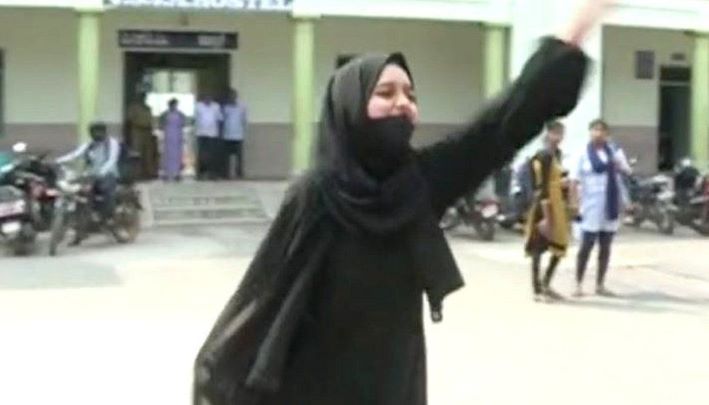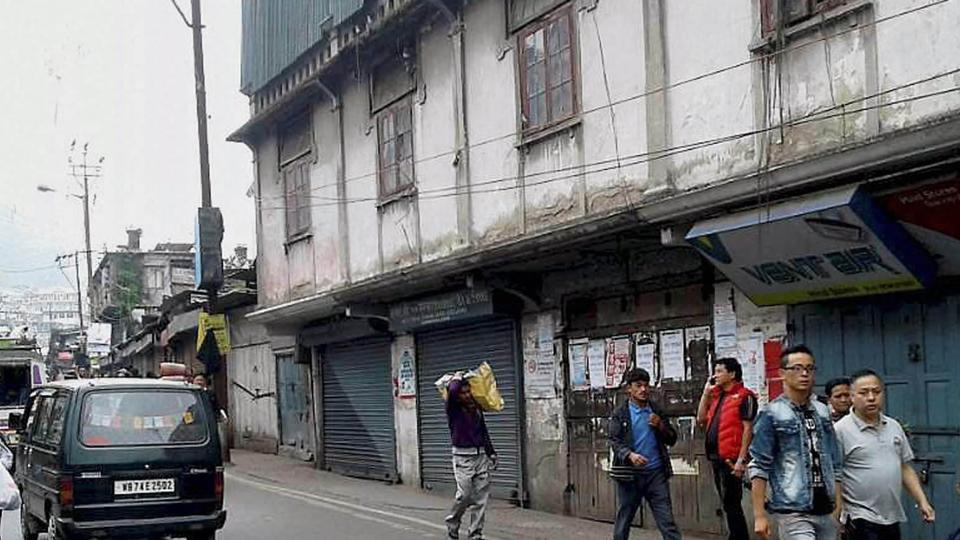Diversity, not Divisiveness is the goal for secular India
Like us on FB page, Share, subscribe, Follow us…be the voice of Free Press!
By Nazarul Islam, Copy Edited by Adam Rizvi, TIO: A disturbing viral video of a burqa-clad girl at a college in the South Indian state of Karnataka, trying to hold her own amidst a swarm of saffron-wearing youths shouting ‘Jai Shri Ram’ and closing in upon her, has signified different things to different people. To some, it is a picture of a lone girl’s courage in the face of a bunch of rowdies heckling her for her choice of attire. To others, it is an ugly exhibition of majoritarian bullying of a Muslim girl and the attempt to stifle her right to religious expression as guaranteed by the Constitution. To many, it is both.
There is, however, a separate dimension to the video clip: In response to the youths’ chants of ‘Jai Shri Ram’ — recognized as the ubiquitous battle cry of militant Hindutva — the burqa-clad girl retaliates by raising her arm and shouting Allahu Akbar (God is great) several times. Obviously, this was an unpleasant scene An unequal face-off….Yes, but then it was a face-off — angry, belligerent, and purely combative. This is what religious polarization looks like. And, this is the bitter harvest of a sustained campaign to promote divisiveness and communal strife.
Also Read: Hijab: My Life, My Right, My Choice, “World Hijab Day”.
Since independence, India has claimed itself to be in the precincts of an institution of secular learning. Unnoticed though, the communal fault lines run so deep now that young people feel compelled to yell out their religion’s war cry loudly — either to bully and smother or to fight back and cling to their identity.
Therefore, the question arises….who profits from such polarization? Who gains when the youth of this vast country expend their energies on competing or provoking a stance of communalism? What purpose is being served by students when, instead of getting busy with their education and building their future, young men and women are busy tripping on the opiate of religion and symbols of faith?
Also Read: Indian Muslims ‘less religious’ – Lowered in comparison upto 2016
India’s southern state of Karnataka has been roiled by the so-called hijab row since last month when six female students were denied entry into their college in Udupi for wearing the hijab, (the Muslim headscarf). The college said that the head or face cover, worn by many Muslim women and girls, went against the college dress code. When the girls stood their ground, several other colleges in the state came out with the same argument.
The Center’s ruling political party—The right-wing BJP government of Karnataka, backed the colleges’ stand, and since then, there have been widespread protests in the state for and against Muslim girls’ right to wear the hijab in educational institutions. Anti-hijab demonstrators bedecked in saffron scarves, the mark of their own Hindu religious identity, have come out in thousands, and their saffronized machismo is now focused on just one goal — prevent Muslim girls from accessing education if they cover their heads in deference to their religion.
Also Read: Elections: Punjab Assembly A Vote for Change! India
The state government’s argument before the Karnataka High Court, which is hearing petitions to uphold the Udupi girls’ right to wear the hijab in the classroom, is that it cannot be allowed in an educational institution since it is not an essential part of Islam.
This logic and fallacious reading are absurd. First, a woman’s choice of attire in an institution of higher education is deemed to be her own business. It needs to be understood that Schools have uniforms, colleges rarely do, because adult citizens or those at the borderline of adulthood are supposed to have freedom of choice in such matters.
Also Read: Groom Arrested! Hindutva is engulfing Little Traditions of India.
Whether a female wants to cover her head or bare her legs — it’s purely her personal choice. And, her personal space needs to be respected. Second, it is not for the state to determine if the hijab is or is not an integral part of Muslim women’s practice of their religion. That is the obvious job of religious scholars. Third, in a country where political leaders representing a secular state make a habit of flaunting religion and religious symbols — the prime minister’s participation in extravagant Hindu rituals and his many eye-popping, saffron-hued ensembles come to mind — it is stunningly discriminatory to argue that Muslim girls cannot wear a headscarf to college because the garment has a religious ‘reference’.
Also Read: Helping Women Get off Sex Trade
Will it be out of context to state that there has never been an outcry over Sikhs wearing a turban or a married Hindu woman sporting a mangal sutra in a college classroom?
I cannot deny that for some, the hijab may be regressive practice, but if a woman chooses to adopt it, you can scarcely deny her right to do the same. There however exists a general consensus that the six Udupi girls’ demand for exercising that right in the classroom must be seen in the context of a body politic where the minority community and its religious and cultural identity have been under severe and sustained attack.
Also Read: Trigs on Track-Diplomacy Unwound -The Ukrainian Crisis
It needs to be highlighted that from the acts of lynching of Muslims on suspicion of possessing beef—to the ferocious tirade against the fanciful ‘love jihad’, from the canceling of multiple namaz sites in Gurgaon to the nefarious Sulli Deal-Bulli Bai apps that sought to humiliate Muslim women online, there has been an incessant attempt to ‘isolate’ the Muslim community, marginalize it or demonize it. Again, the absurd creation of toxicity over actor Shah Rukh Khan’s dua (prayers) before the mortal remains of Bharat Raina, Lata Mangeshkar, and the ridiculous allegation that he had spat on her, could well be the creation of the stuff meant for black comedy.
Also Read: Macron Walking Around Numerous Minefields Raises Islamophobia To Fight Islamic Terror
In truth, it is one more example of the stream of bile that is kept flowing in the direction of Muslims.
The ‘othering’ of Muslims is, of course, the cornerstone of the ruling party’s Hindu nationalist agenda. But it brings electoral rewards too — the greater the divisiveness, the more intense the hostility between Hindus and Muslims, the more likely is the majority community to vote for a party that signals its intent to fight against its “common enemy”.
In the case of the youth, the gains are even more substantive and long-term. Keeping them in a ferment over religious identities — their own and their perceived antagonists — is a neat strategy to get India’s much-touted ‘demographic dividend’ to deliver electoral dividends for the ruling party.
Also Read: Salutation to Hazrat Ali on his martyrdom day; there is none like him in the encyclopedia of Islam.
Besides, it has also taken their minds off such matters as jobs or the lack of it, in a country of 1.30 billion people. According to the Centre for Monitoring Indian Economy (CMIE), India’s unemployment rate stood at a high of 6.57 percent in January 2022, while unemployment in urban India was even higher at 8.16 percent.
The chances of the educated youth finding white-collar jobs in the country’s tiny formal sector — the informal economy employ 90 percent of the country’s workforce — have been getting bleaker in recent years. In such a scenario, it pays to keep them preoccupied with non-issues like which religious symbols may or may not be worn to college.
Also Read: The US House Passes Bill To Combat Islamophobia
Will the fruits of Hindu-Muslim identity politics may eventually be allowed to run out?
Last month protesters in Bihar and Uttar Pradesh set fire to trains because they did not get jobs in the Indian Railways. It’s a signal that economic disaffection will eventually outweigh the opiate of religion.
Until then, the discourse in this country will continue to be dominated by mandir and masjid, hijab and bhagwa, and the strutting of majoritarian might before all other communities.
Compiled and Curated by Humra Kidwai.




